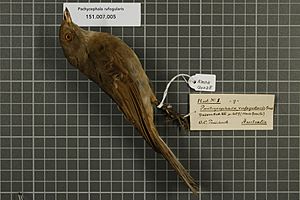Red-lored whistler facts for kids
Quick facts for kids Red-lored whistler |
|
|---|---|
 |
|
| Conservation status | |
| Scientific classification | |
| Genus: |
Pachycephala
|
| Species: |
rufogularis
|
The Red-lored Whistler (Pachycephala rufogularis) is a special bird found only in Australia. It's one of nine types of whistlers that live there. This bird is part of a family called Pachycephalidae, which also includes birds like shrike-thrushes and pitohuis.
This whistler is called "Red-lored" because of the reddish color on its face and throat. It lives in a specific type of forest called Mallee woodland. Because it lives in such a small area, mainly in parts of New South Wales, Victoria, and South Australia, it is listed as a vulnerable species. This means its population is at risk.
Contents
About Its Name
The Red-lored Whistler has a few other names, like the buff-breasted whistler or red-throated whistler. Its scientific name, Pachycephala rufogularis, tells us a bit about the bird. "Pachycephala" means "thick head," and "rufogularis" means "red throat." So, its name literally means "thick head red throat." Whistlers used to be called "Thickheads."
What It Looks Like
The male Red-lored Whistler is quite colorful! It has an orange or buff-colored face and throat. A grey band goes around its neck and over its head. Its belly is reddish-brown, and its wing feathers have pale yellow or olive edges. Some males even have a buff-colored collar.
Female Red-lored Whistlers look similar to males but have paler throats and bellies, with a hint of buff. Both males and females have red eyes, and their beaks and legs are dark. These birds are about 19 to 22 centimeters (about 7.5 to 8.5 inches) long and weigh between 30 and 38 grams (about 1 to 1.3 ounces).
One special thing about the Red-lored Whistler is that the red color on its throat extends up to its face. This helps tell it apart from the Gilbert's Whistler, which also has a red throat but not on its face. Young Red-lored Whistlers and females can be tricky to tell apart from Gilbert's Whistlers, but the Red-lored Whistler often has a bit more buff coloring. Both birds live in the same areas and act very similarly, which can make it even harder to identify them in the wild.
Where It Lives
The Red-lored Whistler makes its home in the dry, low mallee woodlands of central New South Wales, north-western Victoria, and south-eastern South Australia. It likes areas with spinifex plants, cypress pines, and broombush. These birds prefer woodlands or shrublands that have an open tree canopy but a thick, patchy layer of bushes underneath. They are most common in areas that haven't had a major bushfire for 21 to 40 years.
Even though these birds usually stay in one place, some might move around a bit, especially after breeding. They are mostly found in the "Big Desert" or "Ninety-mile Desert" areas of South Australia, especially around the Riverland Biosphere Reserve and Gluepot Reserve. Sadly, the population on the Eyre Peninsula is thought to be gone. In New South Wales, you can find them in the mallee areas of Round Hill Nature Reserve and Nombinnie Nature Reserve. In Victoria, they live in large national parks like the Big Desert, Wyperfield, and Murray-Sunset.
Its Behavior and Life
How It Lives
The Red-lored Whistler is a shy and secretive bird, which makes it hard to spot. Even though it's often seen sitting in trees and bushes, it mostly finds its food on the ground. Not much is known about how far these birds travel, but they are thought to stay in their home areas.
When it's time to build a nest, the Red-lored Whistler creates a strong, cup-shaped nest. It's made mostly of tree bark and mallee leaves, woven neatly together. They usually build these nests in low shrubs and lay 2 to 3 eggs.
Its Call
You might not see a Red-lored Whistler, but you'll often hear it! Its call is described as charming, sweet, and even a bit haunting, with many different notes. If you make a "pishing" sound (like "pssh-pssh"), these birds might even come closer to investigate.
Scientists use special diagrams to study bird calls. A "Sonogram" shows the sounds a bird makes over time, like a picture of its song. The Red-lored Whistler has different types of songs and phrases. Sometimes, you can even hear other birds in their calls, like the Southern Scrub-robin.
Threats to the Red-lored Whistler
The Red-lored Whistler faces several dangers that threaten its survival:
- Habitat Loss: Its home is disappearing because of land clearing, damage, and breaking up into smaller pieces.
- Feral Animals: Animals like goats that are not native to Australia eat the plants the whistlers need.
- Fires: Bushfires and the wrong way of managing fires can harm their habitat.
- Predators: Foxes and cats hunt these birds.
- Natural Disasters: Things like severe droughts and large wildfires can be very damaging.
- Climate Change: Changes in the climate also affect their environment.
Its Conservation Status
The Red-lored Whistler is listed as "Vulnerable" on the IUCN Red List, which is a global list of threatened species. It's also protected under Australia's Environment Protection and Biodiversity Conservation Act of 1999. Many parts of its home are protected as National Parks and reserves.
In the year 2000, there were about 10,000 Red-lored Whistlers, but their numbers were going down. The most recent estimate suggests there are now fewer than 2,000 adult birds left, with about half of them living in the Riverland Biosphere Reserve.
Each state in Australia where the bird lives has its own rules for protecting it:
- New South Wales: It's listed as "Critically Endangered" since 2009.
- South Australia: It's listed as "Vulnerable."
- Victoria: It's listed as "Threatened." In 2007, it was even listed as "Endangered" in Victoria.
See also
 In Spanish: Silbador gorjirrufo para niños
In Spanish: Silbador gorjirrufo para niños


